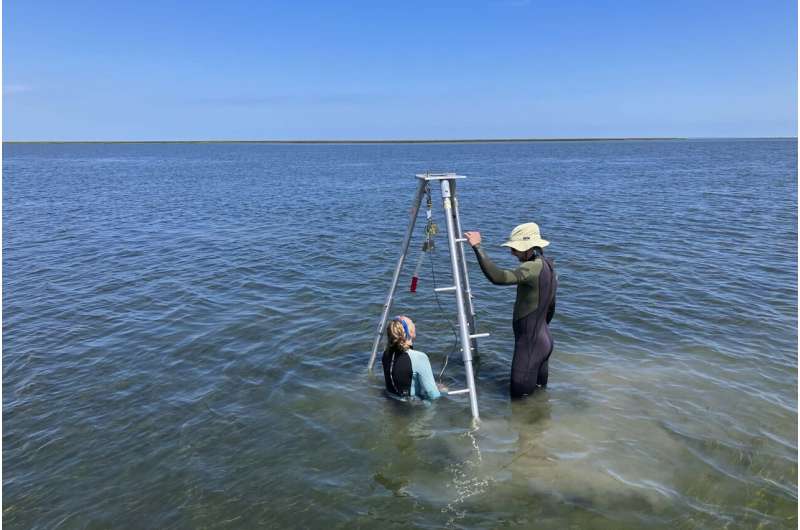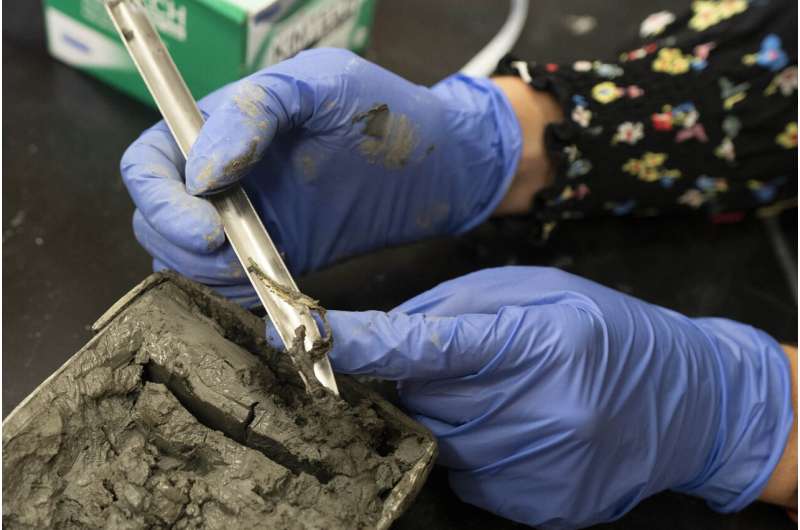This article has been reviewed according to Science X's editorial process and policies. Editors have highlighted the following attributes while ensuring the content's credibility:
fact-checked
trusted source
proofread
With seagrass discovery, we may be one good solution closer to solving climate change

The wetsuit-clad team of University of Virginia explorers waded into the salty shallows of the largest restored seagrass meadow in the world, located off the Eastern Shore of Virginia, near Chesapeake Bay.
They fixed their tall tripod into place by the Delmarva Peninsula, inserted an 8-foot-long tube and placed a small, vibrating machine atop the rig. The mechanism nudged the aluminum cylinders deep into the layers of history beneath them—not unlike inserting a straw into an extra-thick milkshake.
Then, the team fished up the contents.
"We took a couple of long cores, and we were really surprised when we saw what looked like seagrass tissue down at the bottom," said research professor Peter Berg, an expert on how the carbon cycle operates in ocean environments. "Some of the cores took us back to about the year 1000, which is near the time when the Vikings came to the North American continent."
Now, the first samples have returned from lab testing with some very good news.
Berg and his team in the UVA Department of Environmental Sciences have solved the mystery of whether seagrass beds can permanently lock in carbon. They announced Friday that the beds can indeed capture and retain carbon for centuries—even in situations where the seagrass dies off.
The findings offer new optimism for using nature-based solutions in the fight against climate change.
Seagrass sex, life and dating
This much was already known: Zostera marina seagrass—often referred to simply as "eelgrass"—effectively traps carbon dioxide, a greenhouse gas that fuels planetary warming.
Natural storage of this kind also occurs in tidal marshes and mangrove forests. As long as the plants flourish, they will pull carbon dioxide from the air. Scientists refer to the exchange as "blue carbon"—the "blue" being for water.
While it's true the individual shoots of seagrass survive for just a year or two, eelgrass spread is prolific. The plant reproduces both sexually, by the dispersal of seeds in currents, and asexually, by their creeping rootstalks. The result can be sea meadows that cover many square miles and persist for centuries.
That makes eelgrass something of a miracle in a sea that's constantly in flux.
By living close to shorelines, the plants feed on sunlight and grab carbon dioxide from the atmosphere, creating new plant material.
Over time, some of that plant material gets buried in the sediment—essentially turning sea floors into carbon banks.
But the outstanding question has been: What happens to all that stored carbon when seagrass meadows die off, even temporarily?
That has been a real concern for moving forward with blue carbon, Berg said. For example, Virginia's Great Storm of 1933 and an oceanic disease called "slime mold" killed off the seagrass meadow in the now-restored areas the UVA researchers are studying.
What's more, marine heat waves are becoming increasingly common due to climate warming. Since the early 1900s, about 20% of the global seagrass meadows have been lost.
Does the carbon remain locked up in the sediments that anchor seagrass in place? Or does some or all of the trapped carbon dioxide return to the atmosphere, counteracting the climate benefits?
"This question of permanence has been debated a lot," Berg said. "But there has been no strong science behind it—until now."
The researchers realized a rare opportunity was captured in the sediment. They would be able to examine the grainy deposits the way you might examine the rings of a felled tree—only vertically, of course. In this way, they could compare the time periods that span and bookend the decades of meadowland loss following the 1933 storm.
The seagrass meadow was restored in 1999 and now sprawls across 10,000 acres. UVA partners with The Nature Conservancy and the Virginia Institute of Marine Sciences as stewards of the preserve.
To put the finest point on the answer to their question, the scientists had to double as history detectives. They used scientific dating techniques and sediment composition analyses to gather their clues.

Tapping core knowledge
Assistant professor Lauren Miller opened a commercial-sized refrigerator to display her treasure chest of sediment cores—or core halves, to be more specific.
They had each been split down the middle and wrapped in a thin plastic. One side was meant for testing. The other they kept untouched, preserved for future reference.
"This is a library right here," Miller said. "A library that's really hard to get."
Multiple faculty members and a host of students are among the large cast of researchers who have chipped in to collect, catalog and parse the grainy contents down to the atomic level. The UVA Environmental Institute provided a $110,000 grant to help make it all happen.
Miller demonstrated how the cores are prepped for analysis. She removed chunks of precipitated salt, and with a small metal spatula-like tool, scored the contents, which look like wet cement or artist's clay. But the texture, if rubbed between one's thumb and index finger, is cool, mostly dry and powdery.
As she worked, Berg explained the initial process of determining if carbon had been captured throughout.
"You take small samples of the wet sediment, and you dry it at a low temperature, so all the water disappears, and you weigh it," he said. "Then you put it in a high-temperature oven, so all the organic material burns off, and you weigh it again. That difference is the organic matter. You can then convert that to carbon."
The team already had a pretty good idea about which years in history matched certain core depths. But they needed to be exact.
They first performed a lead-210 dating analysis, which traces time through the radioactive decay of lead isotopes. They were able to pinpoint sediment back to around the year 1860.
They then determined the age of older sediment from greater core depths through carbon-14 dating.
Miller, still teasing out the sediment, pointed to a smattering of small, delicate shells she found. Some had been fractured and crushed by natural processes such as storms, making them unfit candidates for carbon dating.
"We can pick out shells from the sediment cores and know when they lived," Miller said. "The shells are like us as people. We're taking in radiocarbon from the atmosphere, into our bodies and into our bones. But when we die, that stops happening. And this radiocarbon decays into different products once organisms die, and we can figure out when they lived in the past."
The final lab analysis was to determine that eelgrass remnants had indeed been captured in those immediate decades before the almost 70-year band of dormancy where the carbon was found trapped.
"Given that the organic matter content is higher in the century-old sediment layers than in the top layers with modern seagrass, I think it is safe to say that close to 100% of carbon captured a long time ago has been preserved in the sediment," Berg said.
In all, the researchers were eyeing a key span of 1,000 years.
So, blue carbon trapping is not only effective, but robust, even in the face of changes to the natural environment. That may be important as the world seeks resilient solutions to the climate dilemma.
"It's a win on many fronts," said environmental scientist Karen McGlathery, the Sherrell J. Aston Professor at UVA and an expert in shallow coastal systems, who contributed to the research.
Additional contributors included postdoctoral researcher Marion McKenzie, and UVA graduate and undergraduate students Renee Hebert, Luke Groff, Charlotte Wiman, Mackenzie Fiss, Sophia Kuzminski, Tahi Wiggins, Santiago Munevar Garcia and Ziwen Guo. Northeastern University professors Samuel Munoz and Aron Stubbins also collaborated.
"Seagrass meadows provide so many benefits beyond blue carbon, like promoting fisheries and improving water quality," McGlathery said. "We are now working on putting a market value on those benefits as well. That will give us the whole picture of why seagrass conservation and restoration are important."
Provided by University of Virginia





















